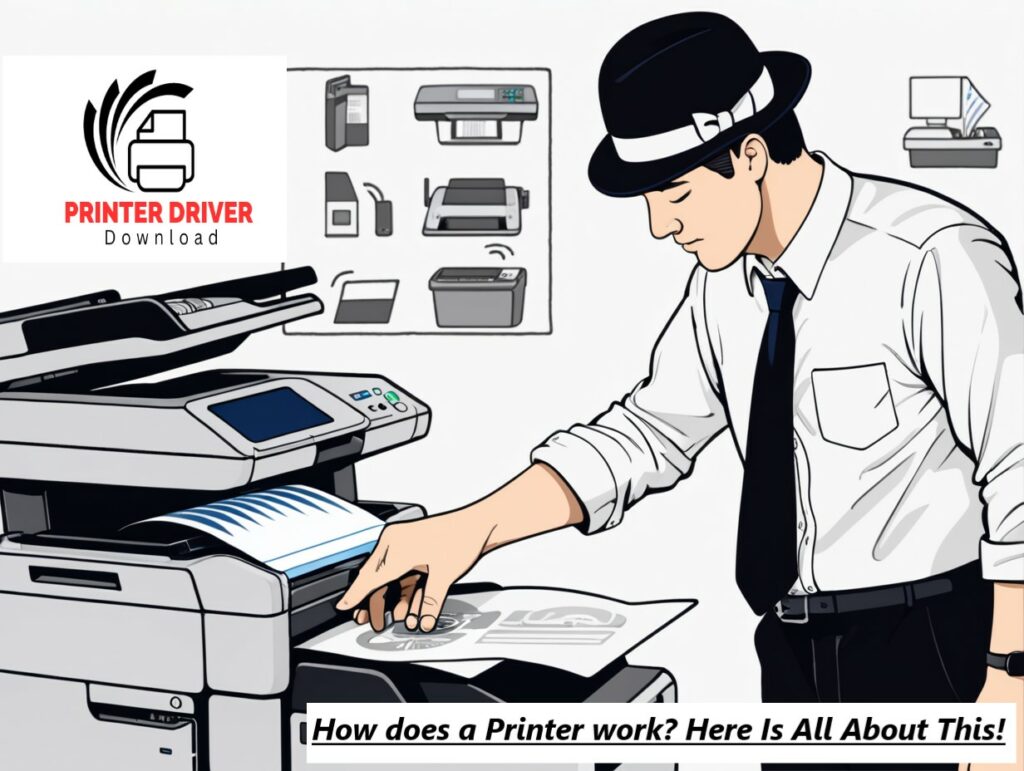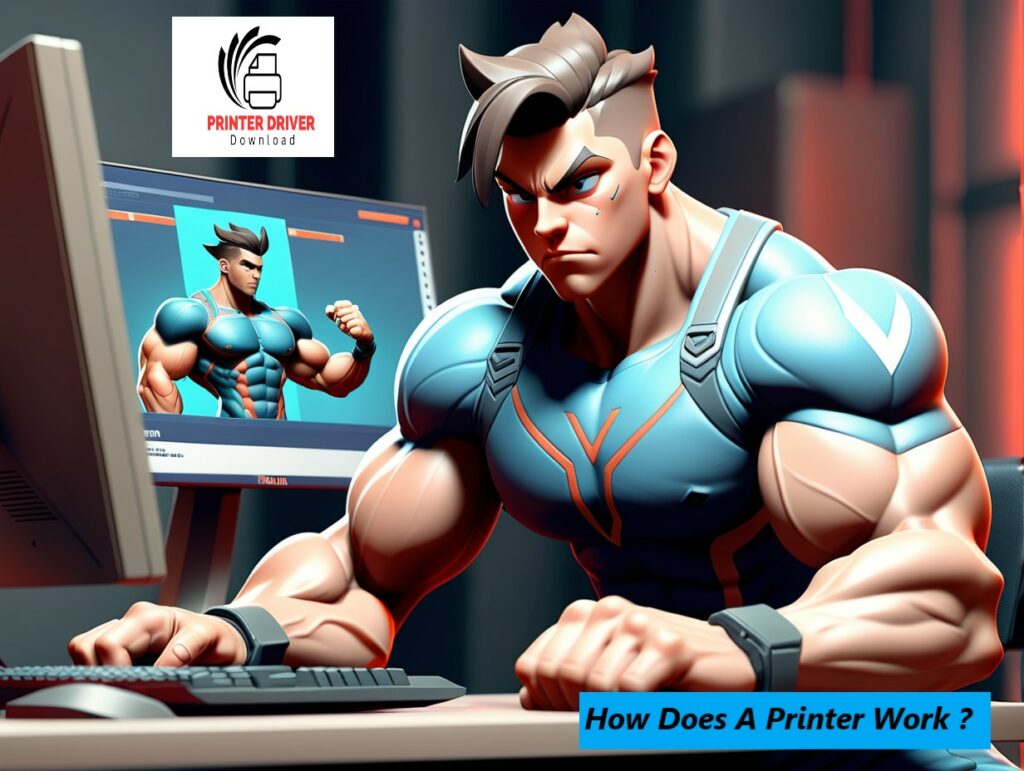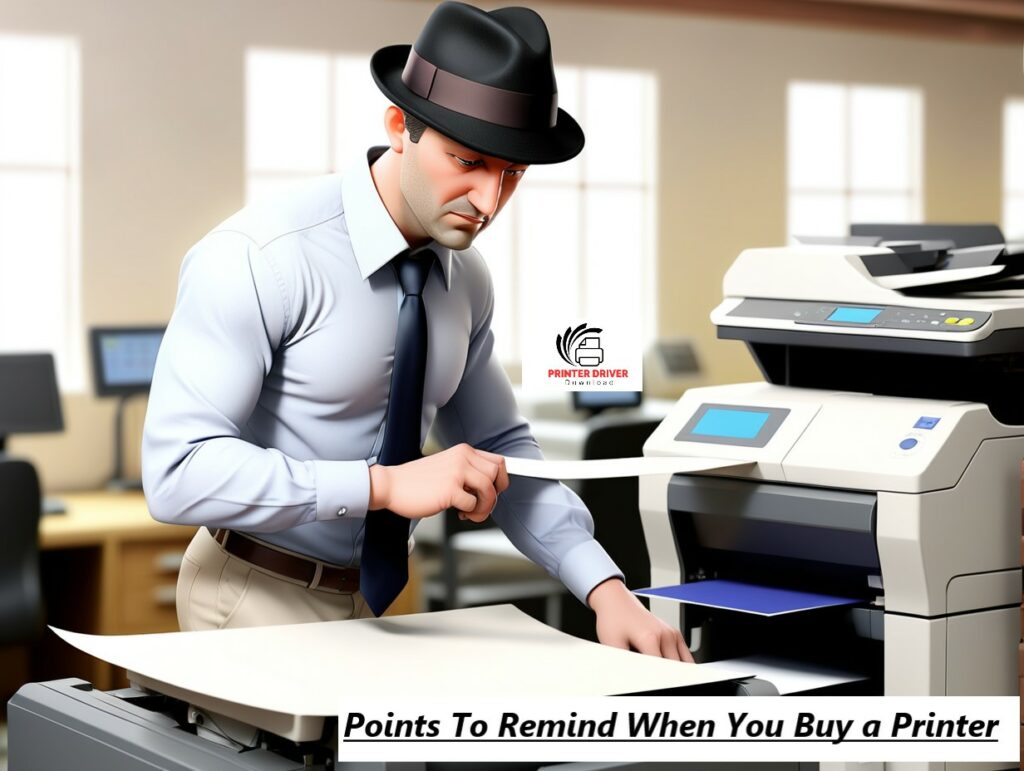From a piece of paper to a printed page, you will get full information about how printer make it possible. So let’s get started.

What Is a Printer?
A printer is a device that accepts text and graphic output from a computer and prints it on paper, typically 8.5″ by 11″. Printers vary in size, speed, sophistication, and price. In general, more expensive printers are utilized for higher-volume printing or high-resolution color printing.
Personal computer printers can be classified as either impact or non-impact printers. Early impact printers worked similarly to an automatic typewriter, with a key making an inked impression on paper for each printed character. Dot matrix printers, which strike the paper one line at a time, were a popular low-cost choice.
The most well-known non-impact printers are inkjet and laser printers. The inkjet sprays ink from an ink cartridge extremely close to the paper as it rolls by, whereas the laser printer utilizes a laser beam reflected from a mirror to attract ink (known as toner) to specific paper locations when a sheet rolls over a drum.
Types Of Printer
Inkjet Printers:
- Uses liquid ink to create images or text on paper.
- Ideal for high-quality photo printing and ordinary household use.
- It might be in color or in monochrome.
Laser Printers:
- Uses toner powder and a laser to print images or text on paper.
- Text documents are processed quickly and efficiently.
- Suitable for high-volume office printing.
Dot Matrix Printers:
- A matrix of small pins is used to strike an ink-soaked ribbon, resulting in dots on paper.
- Frequently used for multipart forms or in situations needing carbon copies.
Thermal Printers:
- Uses heat to create an image on specially treated paper.
- It is widely used in point-of-sale (POS) systems, label printers, and fax machines.
Dye-Sublimation Printers:
- Heat is used to transfer dye to diverse materials such as paper and plastic.
- Produces high-quality photo printouts and is commonly used in professional photo printing.
3D Printers:
- Layer by layer, it creates three-dimensional items out of materials such as plastic, metal, and resin.
- Used for prototyping, production, and even some medicinal applications.
MFPs(Multifunction Printer), sometimes known as all-in-one printers:
- Printing, scanning, copying, and, in certain cases, faxing are all combined into a single device.
- Ideal for home offices and small businesses.
Wide-format printers:
- Designed to print larger papers or illustrations, which frequently exceed the conventional letter or legal sizes.
- Printing huge drawings or posters is common in graphic design, architecture, and engineering.
Plotters:
- Specialized printers that employ pens or blades to create vector drawings on big sheets of paper.
- Precise, detailed drawings are widely utilized in engineering and design.
LED Printers:
- Similar to laser printers, however instead of a laser, an array of light-emitting diodes (LEDs) creates the picture on the drum.
Sublimation Printers:
- Similar to dye sublimation, but commonly used for printing on fabrics, ceramics, and other materials.
Also Learn How To Check Which GPU Is In Your System – 6 Easy Steps
Older Printer Types
Dot Matrix Printers:
- Uses a pin matrix to strike an ink-soaked ribbon, resulting in characters and graphics by forming dots on paper.
- In the 1980s and 1990s, carbon copies were commonly employed when printing documents.
Daisy wheel printers:
- Uses a wheel or disc with raised characters on spokes to make text by striking an inked ribbon.
- Known for creating high-quality text, although slower than current printers.
Line printers:
- Prints one line of text at a time by hitting a ribbon against the paper with a rotating drum.
- Frequently used in corporate settings for high-speed printing of big amounts of text.
Thermal Printer (Non-Direct Thermal):
- To produce characters, use heat-sensitive paper and a heated print head.
- Found in early fax machines and some POS systems.
Chain printers:
- Uses a spinning chain of characters or letters to strike an ink ribbon and transfer text to paper.
- Although not as widespread as other varieties, they were utilized in specific purposes.
Line matrix printers:
- It combines the capabilities of dot matrix and line printers, using a sequence of closely spaced pins to generate lines of characters.
- They are well-known for their long-lasting and fast printing capabilities.
Drum Printers:
- To transfer ink onto paper, use a rotating drum with embossed characters on its surface.
- Common in the early days of computing for mainframe and minicomputer output.
Plotters (pen plotters):
- Draws vector graphics using pens on enormous sheets of paper.
- Engineering and design professionals use it to create precise and detailed drawings.
Chain printers:
- Similar to drum printers, but with a spinning chain of characters striking the paper.
- Used in certain early computer systems.
Impact Printers:
- Includes different types of printers that physically strike an inked ribbon to transfer characters to paper.
- Examples include dot matrix printers, daisy wheel printers, and line printers.
Braille printers:
- Designed specifically to emboss Braille characters on paper for the visually handicapped.
How Does A Printer Work

1. How Does The InkJet Printers Work:
Inkjet printers produce images by propelling small droplets of liquid ink onto paper. The basic components of an inkjet printer are:
Print head: This is a component with small nozzles that spray ink onto paper. The print head goes back and forth across the paper as the printing process progresses.
Ink cartridges hold the ink that the printer uses to print images. They are replaceable, and each cartridge can store a different color.
Process:
- Data Processing: The printer gets digital data from the computer that includes information about the content to be printed.
- Rasterization: The printer turns the digital data into a raster image, which is a collection of dots that represents the final output.
- Ink Ejection: The print head sprays small ink droplets onto the paper, creating the desired picture or text.
- Paper Advancement: The paper is fed into the printer, and the print head goes back and forth across it to cover the entire surface.
- Drying: After the ink has been applied to the paper, it must be allowed to dry before the printed document is handled.
2. How Does A Laser Printer Work:
Laser printers generate images using a distinct technique. The main components of a laser printer are:
Laser printers use toner, a thin powder made up of small pigment particles, rather than liquid ink.
The drum is a cylindrical, negatively charged component. The laser in the printer generates a positive charge pattern on the drum, which corresponds to the image to be printed.
Fuser: The fuser unit employs heat to fuse the toner to the paper.
Process:
- Processing: Similar to inkjet printers, the printer processes digital input to decide content and layout.
- Charging: The drum receives a negative charge.
- Writing: A laser beam creates a positive charge pattern on the drum that corresponds to the image to be printed.
- Developing: The positively charged toner is drawn to the negatively charged parts of the drum.
- Transferring: Toner from the drum is transferred to the paper.
- Fusing: Heat and pressure are used to fuse the toner to the paper.
- Paper Advancement: The printer ejects the paper containing the fused image.
Points To Remind When You Buy a Printer

When selecting a printer, you need to consider a variety of features and considerations to ensure that it suits your individual requirements. Here are some important qualities to look for in a printer:
Printer type
- Inkjet printers: ideal for producing high-quality photos and color documents.
- Laser printers: more efficient for printing high-volume text and monochrome stuff.
Print Speed
- Consider the PPM (pages per minute) or IPM (images per minute) rating. Faster print rates are advantageous for large-scale printing requirements.
Resolution
- Higher-resolution prints are sharper and more detailed, as measured in dots per inch (DPI). A resolution of 600 DPI is normally adequate for general text documents, while a higher DPI is recommended for high-quality pictures.
Functionality
- All-in-One (AIO) printers Include scan, copy, and fax capabilities.
- Multifunction Printers (MFPs) are similar to AIO printers but may include additional functionality.
Connectivity
- Wireless printing allows you to print from your mobile device or PC without using a direct cable connection.
Bluetooth
- Allows printing from Bluetooth-enabled devices.
Cloud Printing
- Support for services such as Google Cloud Print and AirPrint, Paper Handling.
Paper Size
- Make sure the printer can handle the paper sizes you typically use.
Paper Capacity
- A larger paper capacity lowers the need for frequent refills.
Duplex printing
- The ability to print on both sides of paper can save money and lessen environmental effects.
Ink/Toner Costs
- Consider the expense of replacing ink or toner cartridges. Some printers may be inexpensive, but replacement consumables can be costly and easy to Use.
User Interface
- Intuitive control panels and touchscreens can improve the user experience.
Ease of Setup
- Look for straightforward installation and configuration procedures.
Compatibility
- Ensure that the printer is compatible with your operating system (Windows, macOS, or Linux) and devices.
Brand Reputation and Review
- Check customer reviews and the printer brand’s reputation for dependability and customer service.
Energy efficiency
- Printers with energy-saving features, such as automated sleep modes, can help to reduce power use.
Cost
- Consider your budget and the total cost of ownership, which includes consumables and maintenance.
Noise Levels
- If noise is a concern, seek for printers that operate quietly, particularly in shared or quiet office situations.
Warranty & Support
- Check the warranty period and customer support options.
What does collate mean when printing?

When referring to printing, the term “collate” describes the arranging of printed copies in a specified order. When you select the collate option, the printer will arrange the printed pages in the correct order of the document.
For example, if you’re printing a multi-page document in several copies, the collate setting ensures that each complete set of pages (the entire document) is grouped together before proceeding to the next set. This is very handy when printing a document that must be distributed or compiled in a precise sequence, such as a booklet or a report.
Conclusion
So, the next time you press the print button, take a moment to consider the sophisticated ballet of technology that occurs within your printer, changing digital bits into tangible pages. It serves as a reminder that, even in our increasingly digital day, the simple printer remains a source of productivity and a link between the virtual and physical worlds.
Continue Reading …….